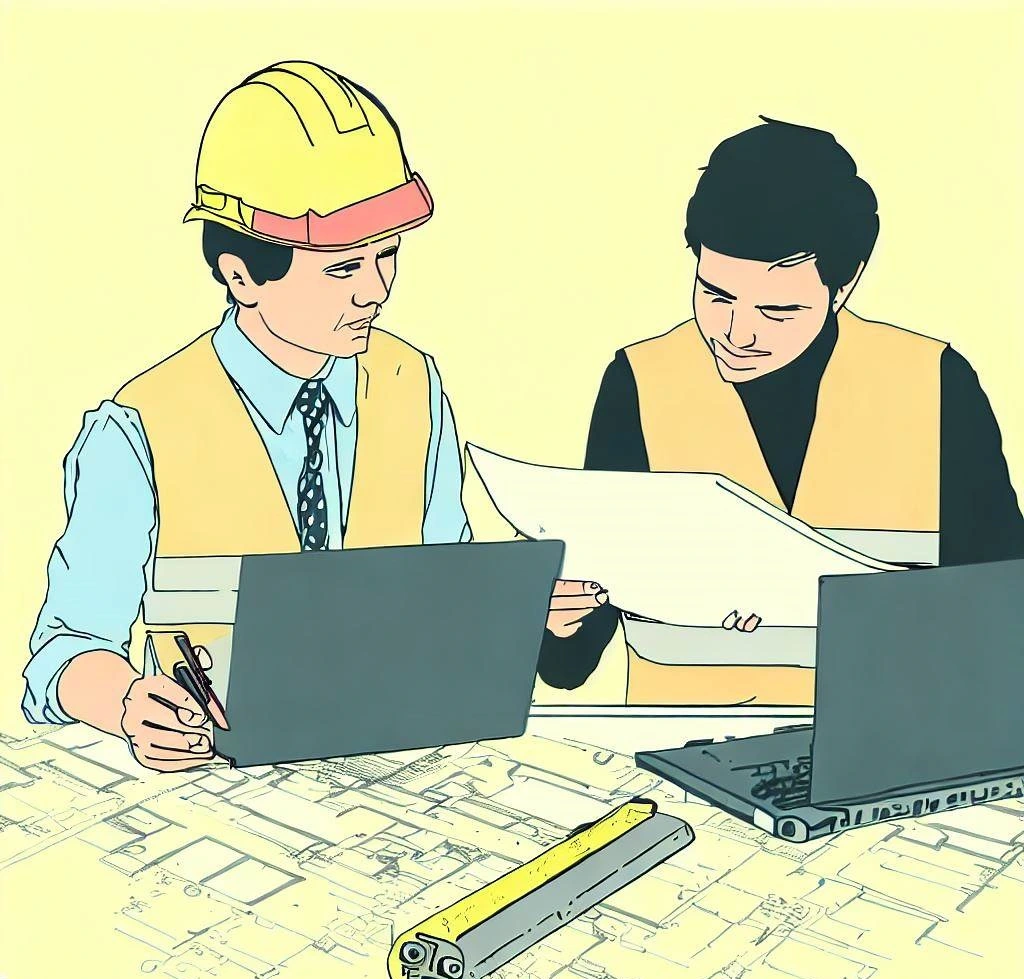- Understanding Why Building Inspection Plans Are Created:
Understanding the intent and significance of building inspection plans is crucial before beginning the assignment. These plans act as a guide for carrying out thorough inspections of structures, spotting potential problems, and suggesting suitable corrective actions. Building inspection plans help maintain structural integrity over time, promote safety, and ensure compliance with building codes and regulations.

For many parties involved, including building owners, tenants, regulatory bodies, and construction experts, building inspections are essential. Students develop a deeper understanding of the role inspections play in ensuring public safety and the durability of buildings by taking part in assignments related to building inspection plans.
- Executing Initial Research:
- Determining Important Inspection Areas:
- Creating Inspection Checklists:
- Describe the Inspection Processes:
- Reporting and documentation
- Examining and Advising Corrective Actions:
- Integrating building regulations and codes:
- Creating Inspection Checklists:
- Describe the Inspection Processes:
- Reporting and documentation
- Examining and Advising Corrective Actions:
Thorough preliminary research is essential to produce a solid building inspection plan. This step entails comprehending the precise needs of the structure or building that is being inspected, including its function, design, construction methods, and pertinent building codes and regulations. Students can better understand the distinctive features of the structure and adjust their inspection plans by digging into the background information.
Researching any previous inspection reports or known problems with comparable structures, in addition to studying the building itself, can help with the assignment by illuminating important details. Students can identify recurring issues, common flaws, or areas that need extra attention during the inspection process by analyzing inspection data from previous inspections.
The next step is to pinpoint the crucial regions of the building or structure that need inspection. Depending on the type of building under inspection, these areas may differ, but common elements include the foundation, structural framing, electrical systems, plumbing, HVAC (heating, ventilation, and air conditioning), fire safety precautions, and accessibility features. Effective inspection planning depends on identifying these areas' criticality and prioritizing them accordingly.
Students can gain a thorough understanding of the various parts that make up a structure by working on assignments that identify key inspection areas. By dissecting the structural components and systems, students gain the ability to assess their state, recognize potential risks, and choose the appropriate inspection methods and tools.
Developing thorough inspection checklists is the next step after identifying the key areas. These checklists act as a methodical road map for inspectors, ensuring that all crucial factors are carefully examined. Each item on the checklist needs to be precise, clear, and compliant with all applicable building rules and regulations.
Students must use critical thinking and take into account a variety of factors when completing assignments involving the creation of inspection checklists. They must conduct research and comprehend the precise specifications listed in building codes, rules, and industry standards. Students improve their understanding of compliance requirements and their capacity to carry out exhaustive inspections by meticulously creating thorough checklists.
Plans for building inspections should clearly outline how to conduct the inspection. Determining the order in which inspections should be conducted and breaking the process down into logical steps are both involved in outlining the inspection procedures. Information on the necessary tools, safety procedures, and any unique techniques or tools to be used during the inspection should all be included in this section. The procedures should be set up to enable a methodical and effective inspection process.
Students are encouraged to think critically and strategically through assignments that focus on outlining inspection processes. They are taught to take into account variables like time management, workflow optimization, and safety precautions. Students gain a thorough understanding of the steps necessary to successfully conduct inspections by developing well-defined inspection procedures.
Building inspection plans must include thorough documentation and reporting. Inspectors must accurately record their findings, making sure that any deficiencies, safety risks, or non-compliance issues are noted. The significance of taking thorough notes, taking photos, and making sketches to support the inspection report can be emphasized in assignments in this area.
The value of paying close attention to detail and the significance of accurately recording inspection findings are lessons that students who take part in such assignments learn. They are aware that thorough documentation is essential for informing stakeholders about inspection findings and facilitating the selection of corrective measures.
After the inspection is complete, it is crucial to analyze the results and suggest the best corrective measures. By evaluating the seriousness and impact of identified problems, students can practice critical thinking through assignments that are centered on this aspect. They can learn to effectively allocate resources and prioritize corrective actions based on risk levels. Students may be inspired by the assignment to consider novel fixes and recommend safeguards against future issues.
Students gain the ability to think critically and assess the effects of identified deficiencies by working on assignments that require them to analyze inspection findings and recommend corrective actions. When recommending effective remediation strategies, they gain the ability to balance various factors, including cost, safety ramifications, and practicability.
To ensure compliance and adherence to standards, building inspection plans must be in accordance with applicable building codes and regulations. Students may be required to conduct extensive research and comprehend the relevant codes as part of this kind of assignment, which will help them gain a thorough understanding of the laws governing building inspections. Students gain experience navigating complex compliance requirements by incorporating these codes and regulations into their plans.
Students have the chance to improve their understanding of the legal aspects related to building inspections through assignments that integrate building codes and regulations. They gain the ability to effectively interpret and apply regulations, ensuring that their inspection plans are thorough and in line with industry standards.
Students are required to take into account a variety of factors and parameters unique to each inspection area when working on assignments focused on developing inspection checklists. For instance, students should become familiar with the pertinent electrical codes and safety regulations before creating a checklist for electrical systems. They must be aware of the various electrical system parts, such as wiring, outlets, switches, and circuit breakers, and they must incorporate particular elements to evaluate the functionality, compliance, and safety of the system.
Similar to this, students should look into the regional plumbing standards and codes before creating a checklist for plumbing inspections. They must contain items that address issues like drainage systems, leak detection, water pressure, fixture functionality, and pipe condition. Students improve their understanding of building systems as well as their capacity to carry out thorough and accurate assessments by painstakingly creating detailed checklists for each area of inspection.
Students must think about the practical aspects of conducting an inspection when completing assignments that outline inspection procedures. They must consider the order of the inspection process to make sure it is logical and effective. When examining a building's exterior, for instance, students might begin with a general visual assessment before looking more closely at structural components, façade integrity, windows, doors, and any distinctive architectural features.
Students also need to think about equipment needs and safety procedures in addition to the sequence. They must learn about and conduct research on the necessary personal protective equipment (PPE), which includes harnesses, safety goggles, hard hats, and gloves. Students may be inspired by assignments to consider each inspection area's potential risks critically and come up with effective safety measures to reduce those risks.
Students should also become familiar with specialized inspection methods and tools. For instance, insulation problems or electrical hotspots can be found using thermal imaging cameras, and potential water damage can be found using moisture meters. Students gain practical experience with the tools used in the field and gain an understanding of their applications by incorporating the use of such tools into their inspection procedures.
The importance of recording inspection findings in a clear and accurate manner is emphasized in assignments that center on documentation and reporting. In order for their reports to accurately depict the state of the structure, students must learn how to effectively communicate their observations.
Assignments may help students adopt a methodical strategy for documentation. This involves labeling photos and sketches clearly, arranging notes according to inspection areas, and comparing observations to the corresponding checklist items. Students should also practice writing succinct yet thorough descriptions of the deficiencies found, including their location, severity, and any applicable codes or regulations related to them.
Students should also be aware that their reports are an essential means of communication between stakeholders and inspectors. They should become adept at organizing and presenting their research in a way that is clear to a variety of readers. As stakeholders depend on the inspection reports to determine necessary repairs, maintenance, or additional assessments, effective documentation and reporting not only ensure transparency but also assist decision-making processes.
Students are challenged to think critically and consider the bigger picture when completing assignments that analyze inspection findings and suggest corrective measures. Students should consider elements like safety risks, potential repercussions, and the building's lifespan when evaluating the severity and impact of issues.
Students may be prompted by assignments to rank corrective measures according to risk. For instance, issues that pose a direct risk to public safety or have an impact on the building's structural soundness should be given higher priority. Along with cost-effectiveness and resource accessibility, students should think about how feasible and useful potential solutions are.
Assignments can also encourage students to consider novel solutions to problems they have been given. They can conduct research and suggest substitute materials, building techniques, or technological advancements that could enhance the structure's durability and long-term performance. Students improve their problem-solving abilities and broaden their understanding of the opportunities for enhancing building performance and safety by taking into account these creative recommendations.
Conclusion:
Students have the opportunity to bridge the gap between theoretical knowledge and practical applications by working on assignments that require them to develop efficient building inspection plans. Students can acquire the abilities to conduct thorough inspections, think critically, and resolve issues in the context of building safety and compliance by following the detailed instructions provided in this article. These assignments promote a thorough understanding of building inspection procedures and aid in the development of future professionals in the field by highlighting the significance of attention to detail, research, documentation, and compliance with regulations.
